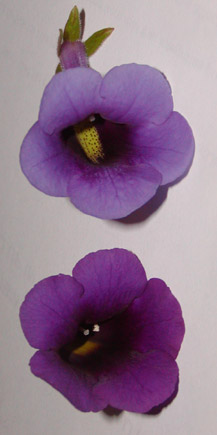Sinningia eumorpha "Saltão" x bragae
At the 2006 Gesneriad Society convention, Bill Price gave me a tuber of his cross between S. eumorpha "Saltão" and S. bragae, the latter species then being known under its holding name of Sinningia sp. "Ibitioca". The hybrid first bloomed for me in May 2007, at the same time as S. bragae.
What a wonderful plant!
The flowers look a lot like those of S. bragae: purple, campanulate (bell-shaped), with a yellow guide in the throat. The habit is derived from S. eumorpha: an erect stem with flowerstalks in the leaf axils. This makes for a tidier plant than the Ibitioca parent, which often sprawls. The hybrid also has (for me, in 2007) four flowers per axil, up from eumorpha's one (or occasionally two).
In November 2009, Bill informed me that he was registering the plant under the name 'Altamont Cascade', Altamont being the neighborhood in which he lives. However, it appears that he has since had second thoughts, so the hybrid remains unregistered, as of June 2019.


